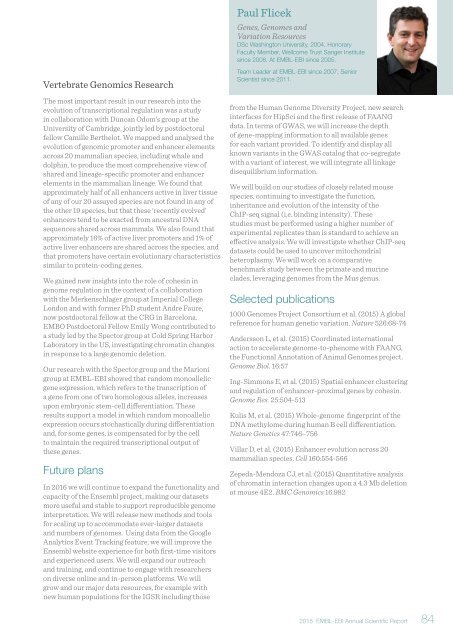Annual Scientific Report 2015
EMBL_EBI_ASR_2015_DigitalEdition
EMBL_EBI_ASR_2015_DigitalEdition
Create successful ePaper yourself
Turn your PDF publications into a flip-book with our unique Google optimized e-Paper software.
Vertebrate Genomics Research<br />
The most important result in our research into the<br />
evolution of transcriptional regulation was a study<br />
in collaboration with Duncan Odom’s group at the<br />
University of Cambridge, jointly led by postdoctoral<br />
fellow Camille Berthelot. We mapped and analysed the<br />
evolution of genomic promoter and enhancer elements<br />
across 20 mammalian species, including whale and<br />
dolphin, to produce the most comprehensive view of<br />
shared and lineage-specific promoter and enhancer<br />
elements in the mammalian lineage. We found that<br />
approximately half of all enhancers active in liver tissue<br />
of any of our 20 assayed species are not found in any of<br />
the other 19 species, but that these ‘recently evolved’<br />
enhancers tend to be exacted from ancestral DNA<br />
sequences shared across mammals. We also found that<br />
approximately 16% of active liver promoters and 1% of<br />
active liver enhancers are shared across the species, and<br />
that promoters have certain evolutionary characteristics<br />
similar to protein-coding genes.<br />
We gained new insights into the role of cohesin in<br />
genome regulation in the context of a collaboration<br />
with the Merkenschlager group at Imperial College<br />
London and with former PhD student Andre Faure,<br />
now postdoctoral fellow at the CRG in Barcelona.<br />
EMBO Postdoctoral Fellow Emily Wong contributed to<br />
a study led by the Spector group at Cold Spring Harbor<br />
Laboratory in the US, investigating chromatin changes<br />
in response to a large genomic deletion.<br />
Our research with the Spector group and the Marioni<br />
group at EMBL-EBI showed that random monoallelic<br />
gene expression, which refers to the transcription of<br />
a gene from one of two homologous alleles, increases<br />
upon embryonic stem-cell differentiation. These<br />
results support a model in which random monoallelic<br />
expression occurs stochastically during differentiation<br />
and, for some genes, is compensated for by the cell<br />
to maintain the required transcriptional output of<br />
these genes.<br />
Future plans<br />
In 2016 we will continue to expand the functionality and<br />
capacity of the Ensembl project, making our datasets<br />
more useful and stable to support reproducible genome<br />
interpretation. We will release new methods and tools<br />
for scaling up to accommodate ever-larger datasets<br />
and numbers of genomes. Using data from the Google<br />
Analytics Event Tracking feature, we will improve the<br />
Ensembl website experience for both first-time visitors<br />
and experienced users. We will expand our outreach<br />
and training, and continue to engage with researchers<br />
on diverse online and in-person platforms. We will<br />
grow and our major data resources, for example with<br />
new human populations for the IGSR including those<br />
Paul Flicek<br />
Genes, Genomes and<br />
Variation Resources<br />
DSc Washington University, 2004. Honorary<br />
Faculty Member, Wellcome Trust Sanger Institute<br />
since 2008. At EMBL-EBI since 2005.<br />
Team Leader at EMBL-EBI since 2007, Senior<br />
Scientist since 2011.<br />
from the Human Genome Diversity Project, new search<br />
interfaces for HipSci and the first release of FAANG<br />
data. In terms of GWAS, we will increase the depth<br />
of gene-mapping information to all available genes<br />
for each variant provided. To identify and display all<br />
known variants in the GWAS catalog that co-segregate<br />
with a variant of interest, we will integrate all linkage<br />
disequilibrium information.<br />
We will build on our studies of closely related mouse<br />
species, continuing to investigate the function,<br />
inheritance and evolution of the intensity of the<br />
ChIP-seq signal (i.e. binding intensity). These<br />
studies must be performed using a higher number of<br />
experimental replicates than is standard to achieve an<br />
effective analysis. We will investigate whether ChIP-seq<br />
datasets could be used to uncover mitochondrial<br />
heteroplasmy. We will work on a comparative<br />
benchmark study between the primate and murine<br />
clades, leveraging genomes from the Mus genus.<br />
Selected publications<br />
1000 Genomes Project Consortium et al. (<strong>2015</strong>) A global<br />
reference for human genetic variation. Nature 526:68-74<br />
Andersson L, et al. (<strong>2015</strong>) Coordinated international<br />
action to accelerate genome-to-phenome with FAANG,<br />
the Functional Annotation of Animal Genomes project.<br />
Genome Biol. 16:57<br />
Ing-Simmons E, et al. (<strong>2015</strong>) Spatial enhancer clustering<br />
and regulation of enhancer-proximal genes by cohesin.<br />
Genome Res. 25:504-513<br />
Kulis M, et al. (<strong>2015</strong>) Whole-genome fingerprint of the<br />
DNA methylome during human B cell differentiation.<br />
Nature Genetics 47:746–756<br />
Villar D, et al. (<strong>2015</strong>) Enhancer evolution across 20<br />
mammalian species. Cell 160:554-566<br />
Zepeda-Mendoza CJ, et al. (<strong>2015</strong>) Quantitative analysis<br />
of chromatin interaction changes upon a 4.3 Mb deletion<br />
at mouse 4E2. BMC Genomics 16:982<br />
<strong>2015</strong> EMBL-EBI <strong>Annual</strong> <strong>Scientific</strong> <strong>Report</strong> 84


